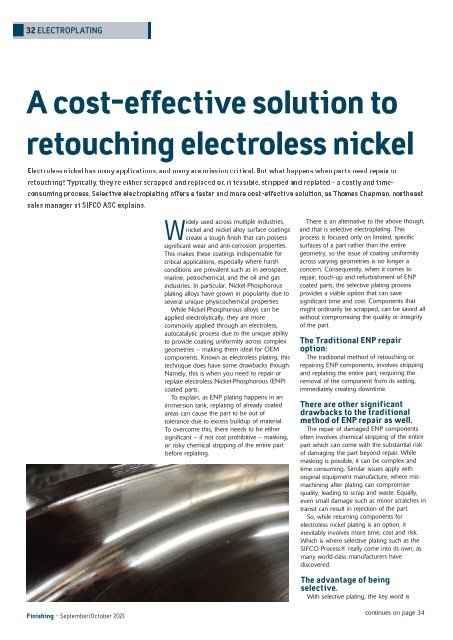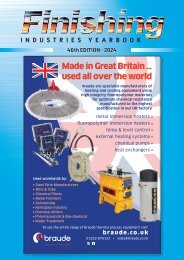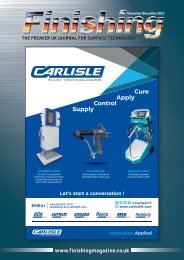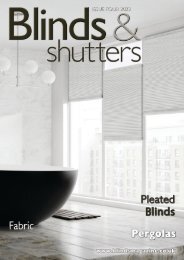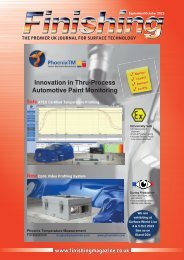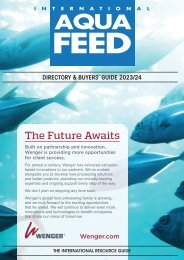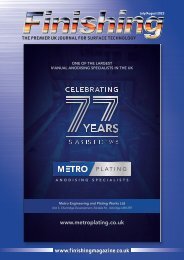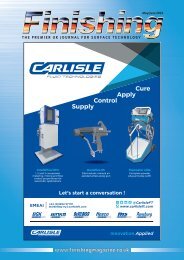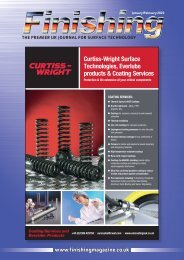Create successful ePaper yourself
Turn your PDF publications into a flip-book with our unique Google optimized e-Paper software.
32 ELECTROPLATING<br />
A cost-effective solution to<br />
retouching electroless nickel<br />
Widely used across multiple industries,<br />
nickel and nickel alloy surface coatings<br />
create a tough finish that can possess<br />
significant wear and anti-corrosion properties.<br />
This makes these coatings indispensable for<br />
critical applications, especially where harsh<br />
conditions are prevalent such as in aerospace,<br />
marine, petrochemical, and the oil and gas<br />
industries. In particular, Nickel-Phosphorous<br />
plating alloys have grown in popularity due to<br />
several unique physicochemical properties.<br />
While Nickel-Phosphorous alloys can be<br />
applied electrolytically, they are more<br />
commonly applied through an electroless,<br />
autocatalytic process due to the unique ability<br />
to provide coating uniformity across complex<br />
geometries – making them ideal for OEM<br />
components. Known as electroless plating, this<br />
technique does have some drawbacks though.<br />
Namely, this is when you need to repair or<br />
replate electroless Nickel-Phosphorous (ENP)<br />
coated parts.<br />
To explain, as ENP plating happens in an<br />
immersion tank, replating of already coated<br />
areas can cause the part to be out of<br />
tolerance due to excess buildup of material.<br />
To overcome this, there needs to be either<br />
significant – if not cost prohibitive – masking,<br />
or risky chemical stripping of the entire part<br />
before replating.<br />
There is an alternative to the above though,<br />
and that is selective electroplating. This<br />
process is focused only on limited, specific<br />
surfaces of a part rather than the entire<br />
geometry, so the issue of coating uniformity<br />
across varying geometries is no longer a<br />
concern. Consequently, when it comes to<br />
repair, touch-up and refurbishment of ENP<br />
coated parts, the selective plating process<br />
provides a viable option that can save<br />
significant time and cost. Components that<br />
might ordinarily be scrapped, can be saved all<br />
without compromising the quality or integrity<br />
of the part.<br />
The Traditional ENP repair<br />
option:<br />
The traditional method of retouching or<br />
repairing ENP components, involves stripping<br />
and replating the entire part; requiring the<br />
removal of the component from its setting,<br />
immediately creating downtime.<br />
There are other significant<br />
drawbacks to the traditional<br />
method of ENP repair as well.<br />
The repair of damaged ENP components<br />
often involves chemical stripping of the entire<br />
part which can come with the substantial risk<br />
of damaging the part beyond repair. While<br />
masking is possible, it can be complex and<br />
time consuming. Similar issues apply with<br />
original equipment manufacture, where mismachining<br />
after plating can compromise<br />
quality, leading to scrap and waste. Equally,<br />
even small damage such as minor scratches in<br />
transit can result in rejection of the part.<br />
So, while returning components for<br />
electroless nickel plating is an option, it<br />
inevitably involves more time, cost and risk.<br />
Which is where selective plating such as the<br />
SIFCO Process® really come into its own, as<br />
many world-class manufacturers have<br />
discovered.<br />
The advantage of being<br />
selective.<br />
With selective plating, the key word is<br />
<strong>Finishing</strong> - <strong>September</strong>/<strong>October</strong> <strong>2021</strong><br />
continues on page 34


